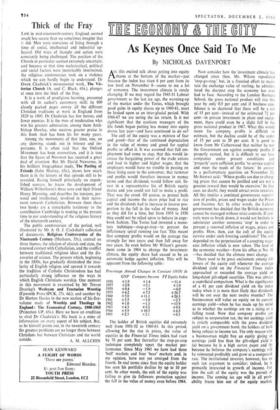Thick of the Fray
LIFE in mid-nineteenth-century England seemed much less secure than we sometimes imagine that it did. Men were conscious of living through a time of social, intellectual and industrial up- heaval. Old ways of thought and action were constantly being challenged. The position of the Church in particular seemed extremely uncertain; and because at that time ecclesiastical, political and social factors were inextricably intertwined, the religious controversies took on a violence which we can hardly begin to understand. Dr Owen Chadwick's monumental work, The Vic- torian Church (A. and C. Black, 63s.), plunges at once into the thick of the fray.
It is a work of prodigious learning, presented with all its author's customary skill; its 600 closely packed pages survey all the different Christian traditions at work in England from 1829 to 1860. Dr Chadwick has few heroes, and fewer enemies. It is the men of moderation who win his greatest admiration, among them Arch- bishop Howley, who receives greater praise in this book than has been his for many years.
Among the movements of that time, one, on any showing, stands out in interest and im- portance. It is often said that the Oxford Movement has been overwritten, and it is true that the figure of Newman has received a great deal of attention. But Mr David Newsome, in his brilliant biographical study, The Parting of Friends (John Murray, 63s.), shows how much there is in the history of that episode still to be revealed. Basing himself principally on unpub- lished sources, he traces the development of William Wilberforce's three sons and their friend Henry Manning, and describes the tensions, per- sonal and intellectual, involved in their move- ment towards Catholicism. Between them these two books are a remarkable testimony to the contribution Cambridge is making at the present time to our understanding of the religious history of the nineteenth century.
The public controversies of the period, well illustrated by Mr A. 0. J. Cockshut's collection of documents, Religious Controversies of the Nineteenth Century (Methuen, 35s.), centred on three themes, the relation of church and state, the renewed contact with Catholicism, and the conflict between traditional religious ideas and the dis- coveries of science. The process which, beginning in the 1830s, has gradually diminished the insu- larity of English religion and opened it towards the tradition of Catholic Christendom has had particularly strong influence on the ways in which English Christians worship. One moment in this movement is examined by Mr Trevor Dearing's Wesleyan and Tractarian Worship (Epworth Press/SPCK, 27s. 6d.); and another by Dr Horton Davies in the new section of his five- volume study of Worship and Theology in England : The Ecumenical Century, 1900-1965 (Princeton UP, 65s.). Here we have an erudition to rival Dr Chadwick's. His book is a mine of information on every aspect of his subject. But, as he himself points out, in the twentieth century the greatest problems are no longer those between Christians but between Christians and the world


































 Previous page
Previous page